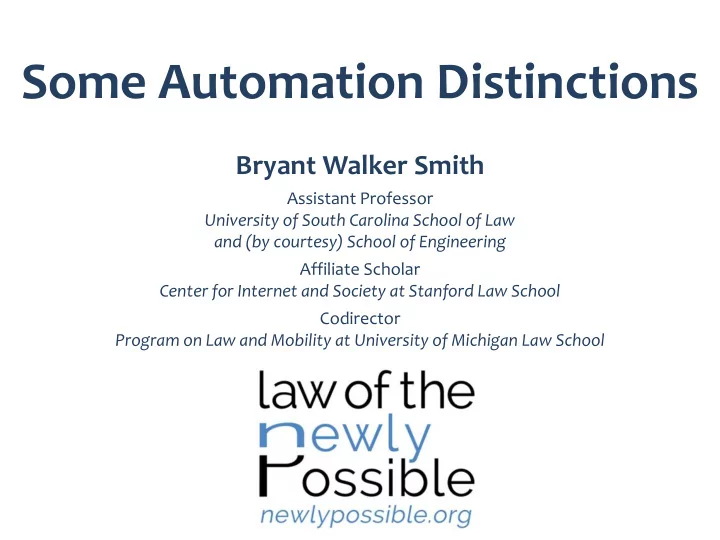

Some Automation Distinctions Bryant Walker Smith Assistant Professor University of South Carolina School of Law and (by courtesy) School of Engineering Affiliate Scholar Center for Internet and Society at Stanford Law School Codirector Program on Law and Mobility at University of Michigan Law School
Certainty Ambiguity
Help Hurt
Lunch No lunch
Traffic safety for middle- and low-income countries Traffic safety for high- income countries
Automation for middle- and low-income countries Automation for high-income countries
Types of trips Types of features Types of vehicles
On reaching a crash site, an ADS-equipped vehicle stops in its lane until someone at a monitoring center sketches a travel path. Using its sensors, it then follows this path. 1) Did the ADS achieve a minimal risk condition? 2) Was there a remote driver?
International law harming innovation Innovation harming international law
AVs have human “drivers” AVs have “drivers” of some kind Article 8 does not apply to AVs Conventions do not apply to AVs
Different paths to the same goal
Comfortable with legal status Want more comfort with legal status
Want specific rules before deployment Want specific rules informed by deployment
Amend rarely Amend regularly
Obligations under 1949 Convention Obligations under both Conventions Obligations under 1968 Convention
If • A, B, C agree that all phones must be green • B, C, D agree that all phones must be red Then • Phones in A must be only green • Phones in D must be only red • Phones in B and C must be both only green and only red — impossible!
Convention on Road Traffic (1949) Geneva Conventions [international humanitarian law] (1949) Agreement on Technical Regulations (1958) Charter of the United Nations (1945) North Atlantic Treaty (1949) General Agreement on Tariffs and Trade (1947)
Change substantive legal obligations Clarify substantive legal obligations
“Driver” as a legal term in the conventions “Driver” as shorthand for a set of responsibilities
Individuals operate AVs Computers operate AVs Companies operate AVs
Prospective safety standards Retrospective safety standards
Retrospective At least as safe as a human in the maneuver and At least as safe as a comparable ADS and Safer than the ADS that just crashed
Prospective Are the companies developing and deploying an automated vehicle worthy of our trust ?
Focus on goals Say what you mean Don’t let the perfect be the enemy of the good
Recommend
More recommend